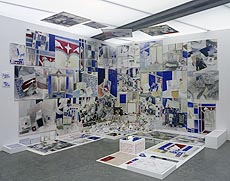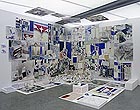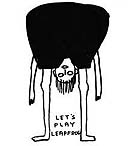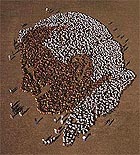
translated and summarized by: Liz Wollner-Grandville,
October 22 - 29
Generali Foundation: Anna Oppermann - Ensembles
Particle accelerator
Adrian Piper, Martha Rosler, Mary Kelly: One of the main merits of the Generali Foundation under the directorship of Sabine Breitwieser was to introduce artists in carefully curated exhibits, who had until then been underrepresented in Austria. It is doubtful if this tradition will be continued in view of the unfortunate merger with the BAWAG Foundation into the equally unfortunate creation of the "Foundation(s)quarter".
The last Generali Foundation exhibit under Breitwieser displays Ensembles by Anna Oppermann (1940 - 1993) for the first time in Austria. Oppermann was an obsessive collector, long before someone like Jonathan Meese was even born. But that is the only level on which they should be compared. Oppermann`s ensembles are meditative, dense, complex installations, offering more intellectuality, philosophy and self-reflection than Meese`s work ever did.
She arranges stage-like settings for paintings, drawings, photos - often taken from preceding presentations of her ensembles, in which altars have been set up in a corner and photos, drawings, newspaper clippings and objects are lovingly placed upon them.
Threads are spun between the numerous particles of her ensembles and individual motifs are often repeated. Like the image of a body, seen from the perspective of its own eyes, resembling Ernst Mach`s sketch in his "Analysis of Sentience". In spite of her seemingly airy-fairy attitude, Oppermann`s works are relevant to the present time; they have nothing evasive.
(1040 Wien, Wiedner Hauptstrasse 15, until 16. December 2007)
foundation.generali.at
Malmö Konsthall: David Shrigley - Everything must have a name
Hopefully easy to digest
When David Shrigley alleges that he does not really have the talent to draw or to write, he is probably being overmodest; but on the other hand he may just be coquet. Shrigley, born 1968 in Glasgow, is well known for his deceptively amateurish cartoons, which have been displayed in museums and galleries since the 90s. For the past two years, his illustrations are published every week in The Guardian. The Malmö exhibit is rather inhomogeneous and displays both his early and most recent works, some of which were made specifically for the Malmö Konsthall.
In 20 cabinet-like spaces his extensive work ranging from illustrations, greeting cards, coffee mugs and sculptures is shown. Among them unconventionally arranged stuffed animals, shady and amorphously filled camping utensils, or an entire room full of copulating insects, made of simple metal bars. "His art manages to be both clever and moronic, relentlessly stupid and occasionally profound", Adrian Searles writes in the The Guardian.
Shrigley`s work can leave the observer clueless but simultaneously somehow amused. His animated films and photographs, however, are much more persuasive, even if they are - according to Searles - "amateurish, childlike scribbles trying to depict everyday absurdities or morbid caricatures, often times disturbing and disconcerting, but always well dosed".
Most of Shrigley`s photographic documentations are characterized by crude motion sequences of delightfully dainty figures, that are suddenly involved in perfidious and violent actions, like the lovesick squirrel suddenly biting the head off its beloved one or the cowboy stuffing his horse into the clothes washer. But in any case, with his unique sense of humor and ironic touch, Shrigley offers a bearable airiness in his work, which is missing in many other art productions.
(200 10 Malmö, St. Johannesgatan 7, until 4. November 2007)
www.konsthall.malmo.se
Camera Austria: What we bought
Swamped by consumer goods
You can twist and turn it as you like - somehow it doesn`t make sense. The title of the exhibit is clearly associated with consumption, materialism and capitalism, while the exhibit itself displays outstanding artwork focused on the appropriateness and frontier crossing of primarily western cultures. But unfortunately it is nearly impossible to match the exhibit`s title with its content.
The content of Manfred Willmann`s most recent work "Chaos pictures", effortlessly matches its name and is probably the only piece of art in line with the topic of the exhibit. One gets the sense of an individual swamped by consumer goods who is just about to lose control. The pink frames around the black and white photos of Svetlana Heger`s series "Ornamental Remix" are impressive and insinuate that a skull has become more or less a fetish these days. However, there is no connection whatsoever to consumerism or hyper-design.
With this exhibit, Camera Austria dares to step out of photography for the very first time and also displays sculptures - but this is where it stumbles. Nicole Werner`s "Double Sand Table" transforms an ashtray into a beautiful eye catcher. But there again - you have an insurmountable breach to the connection and the content of all other work displayed.
The high qualitity of John Armleder`s work, the bizarre video by Olaf Breuning and the stunning portrait of the last pope by Piotr Uklanski are all definitely worthwhile visiting. Best advice: concentrate on every piece and forget about the theme of the exhibit.
(8020 Graz, Kunsthaus Graz, Lendkai 1, until 18. November)
www.camera-austria.at
Neue Galerie Graz: UN/FAIR TRADE - Die Kunst der Gerechtigkeit
The right (eous) way
What started last year as "Slum", and was meant to be an altercation with economic equality and its outcome, is continued in this year’s Styrian fall (steirischer Herbst) and cut right to the chase by the Neue Galerie Graz. Peter Weibel, the chief curator, drew on unlimited resources and selected 30 artists from 17 different nations for the exhibit "UN/FAIR TRADE - The art of equity". Each piece has something to do with trade -trademarks, design, markets, booming world trade, and the vast fortune that can be acquired.
The audience in Graz is lucky to view works by Andreas Gursky, Santiago Sierra and Allan Sekula. Impressive pieces by Romuald Hazoumé and Ecke Bonk (also shown at the documenta 12 uncover and depict insider information in graphical and typological austerity, are on display at the Neue Galerie as is Yuken Teruya. He uses the silhouette-technique and creates a poetic tree landscape out of a fast-food bag, thereby visualizing Aristotle’s principle of the immanent potential of objects.
It is left to the audience to decide if the show displays equitable art. In any case, all of the works more or less subtly cover the topic of (un)fair world trade. One could however doubt that this exhibit can be considered a pendant or even an alternative to the "failed anti-globalization debate", as stated in the press release.
(8010 Graz, Sackstrasse 16, until 25 November 2007)
www.neuegalerie.at
Mehr Texte von translated and summarized by: Liz Wollner-Grandville


 Teilen
Teilen




